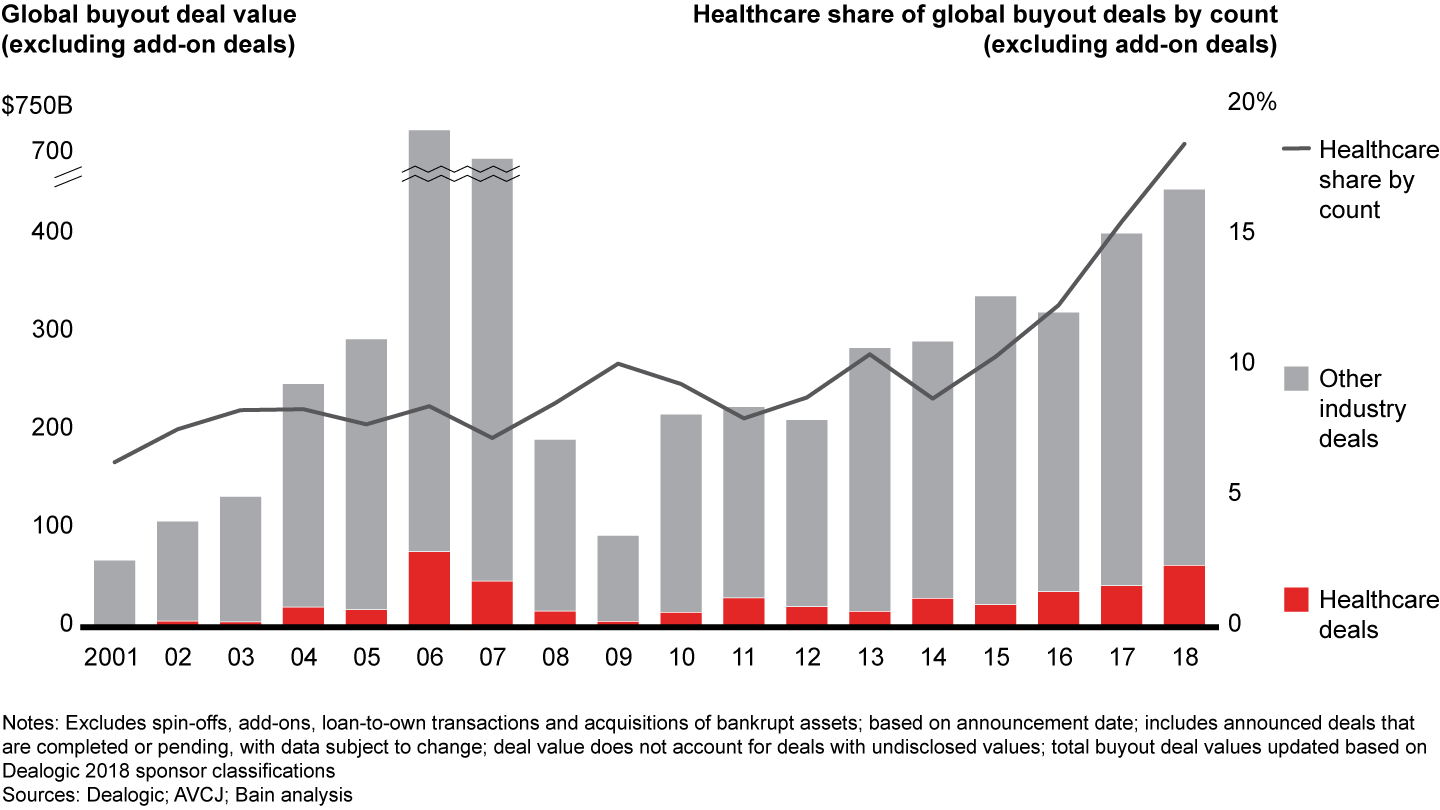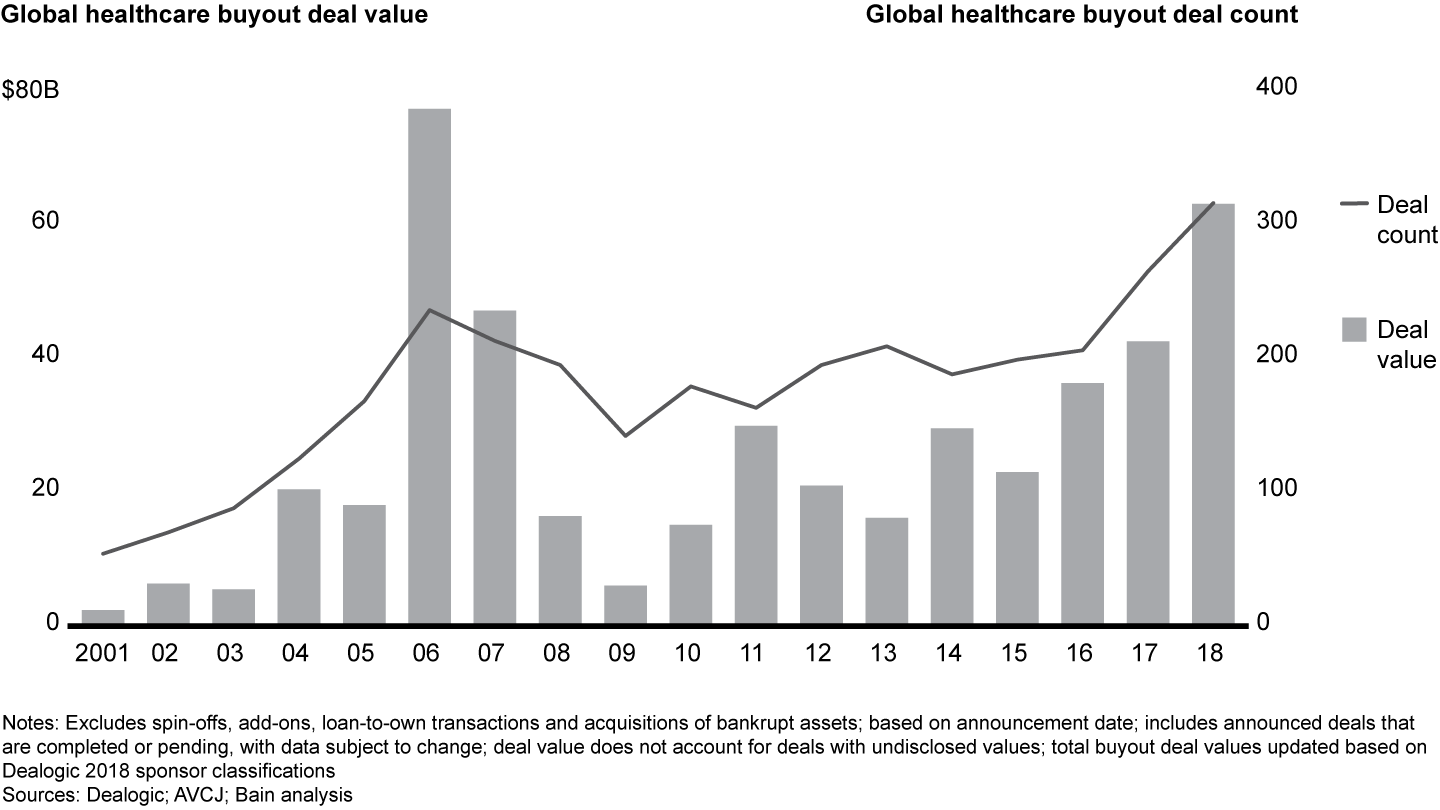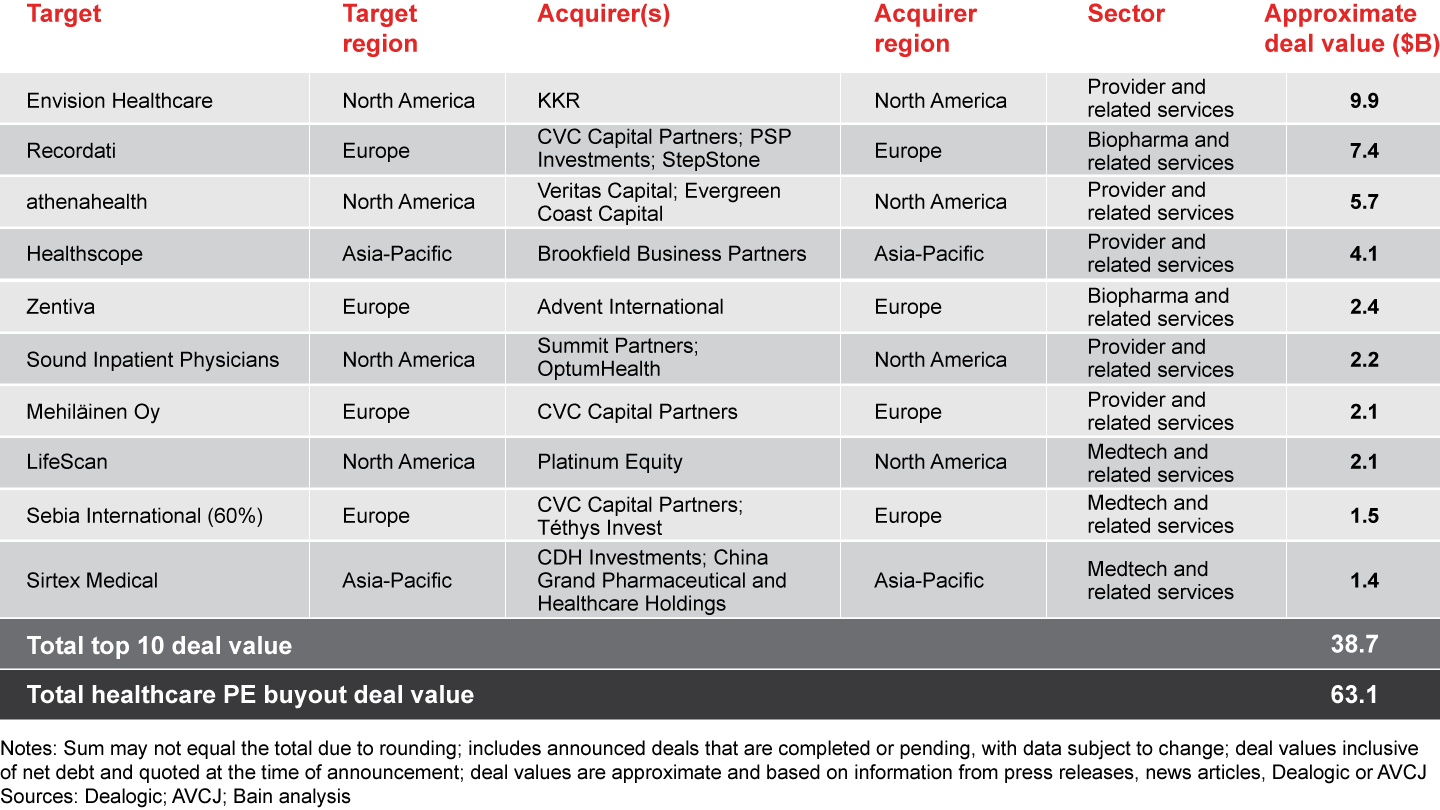Report

Auf einen Blick
- Der Gesamtwert aller offengelegten Private-Equity-Transaktionen belief sich auf 63,1 Milliarden US-Dollar, was den höchsten Wert seit 2006 darstellt. Die Zahl der Transaktionen lag 2017 noch bei 265 und stieg dann auf 316.
- Nordamerika bleibt die aktivste Region, während Gesundheitsdienste und damit verbundene Dienstleistungen nach wie vor der aktivste Sektor sind.
- PE-Fonds haben das Spektrum ihrer Transaktionsstrategien erweitert und setzen vermehrt auf Partnerschaften, öffentliche Märkte, unkonventionelle Buy-out-Strukturen und kreative Wertschöpfungsstrategien.
Dieser Artikel ist Teil des „Global Healthcare Private Equity and Corporate M&A Report 2019“ von Bain. Hier erhalten Sie einen Überblick über den Inhalt des Reports oder laden Sie die PDF-Datei des vollständigen Reports herunter.
Beyond healthcare, private equity overall confirmed its enduring strength as an asset class by continuing a multiyear run of growth in 2018. Disclosed deal values rose 11%, to $447 billion, while deal activity stayed flat at 1,705 deals (excluding add-ons). Despite intense competition for assets, rising US interest rates and tighter access to credit, ample dry powder and a track record of returns for the asset class ensured a strong year for PE investing.
Delving into healthcare, any way you look at it, the sector had a banner year (see Figures 1 and 2). Excluding add-ons, deal volume increased by almost 20% year over year, to 316 transactions, and total disclosed deal value grew by almost 50%, from $42.6 billion in 2017 to $63.1 billion in 2018, as investors announced several megadeals. Unlike in 2017, when only one such transaction closed, 2018 saw four assets trade for more than $4.0 billion, including the largest buyout in at least the past decade: KKR closed a $9.9 billion acquisition of Envision Healthcare in October (see Figure 3).


High valuations were derived in part from intense competition from financial sponsors and corporate acquirers. Corporate M&A deal value rose by roughly 30% in 2018 as healthcare companies turned to acquisitions in order to drive revenue growth, given that multiple and margin expansion have slowed in recent years.

Deal activity and values were robust globally, setting post-recession highs across regions. While North America continued to account for the most deals and highest values, the European and Asia-Pacific regions reached historically high levels in value. In Europe, a handful of large buyouts, including two biopharma deals, led to a significant increase in deal values. And the Asia-Pacific region experienced a spike in activity as investors looked to tap into demand from a healthcare consumer class that has continued to grow in recent years.
Alongside deal activity, our report last year anticipated several trends that emerged in 2018.
First, as the economic expansion extended further beyond historical norms, investors flocked to recession-resistant healthcare investments ahead of an inevitable downturn. We saw significant activity across all segments of the value chain. Pharma, one of the most attractive segments, experienced strong activity, such as the Recordati and Zentiva deals. And the athenahealth and GE Healthcare buyouts, collectively valued at almost $7 billion, speak to the lure of HCIT. Moreover, funds pushed beyond traditional retail health assets into niches such as behavioral health, where autism and other specialty segments hold the promise of sufficient returns, as evidenced by Blackstone’s acquisition of the Center for Autism and Related Disorders (CARD).
Beyond some of the more anticipated sector trends, investors continued to make bets on the consumerization of health, including the rise of concierge care, telemedicine and home health models. The Carlyle Group made a $350 million minority investment into 1Life Healthcare, the technology and management company affiliated with One Medical, an independent network of concierge primary care services.
Payer services attracted growing interest as well, evidenced by Clayton, Dubilier & Rice’s (CD&R) majority stake acquisition of naviHealth and General Atlantic’s investment in Landmark Health, as investors take positions on the growing trends around Medicare Advantage and complex populations.
The second major trend was that deal sizes remained high. Funds pursued larger deals with bigger checks as they were willing to lean in with the support of more robust, integrated commercial and operational due diligence as well as value-creation plans. This occurred across other industries, not just in healthcare, with the average disclosed deal value rising significantly across the board.
We also foresaw that multiples would remain elevated. This was borne out anecdotally, as stiff competition for high-quality assets supported enterprise value to earnings before interest, tax, depreciation and amortization multiples that were in line with past years. The continued rise in multiples leaves investors to ponder whether deal returns for this vintage will be as compelling as past vintages. While the bar is rising, we believe that investors pursuing sophisticated value-creation plans on well-chosen assets will still realize strong deal returns.
Perhaps the most interesting trend that we anticipated is how funds responded to intense competition for deals with an increasingly wide range of approaches. Funds partnered with multiple investors to minimize the risk on buyouts of larger assets. For example, following TPG, Welsh, Carson, Anderson & Stowe, and Humana’s acquisition of Kindred Healthcare, the consortium continued building its hospice platform by acquiring Curo Health Services. These types of add-on acquisitions increased as funds preferred to incrementally invest in their own high-quality portfolio companies and platforms rather than compete for high-priced assets in which they do not have an operational advantage. Another approach took shape in the form of larger corporate carve-outs and take-privates as investors sought more attractive valuations in public assets. These measures of flexibility, among others, have become essential for success in a market that is one of the most attractive and competitive in all of private equity.


